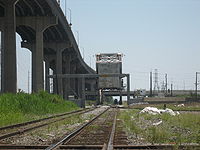
Almonaster Avenue Bridge
Encyclopedia

Bascule bridge
A bascule bridge is a moveable bridge with a counterweight that continuously balances the span, or "leaf," throughout the entire upward swing in providing clearance for boat traffic....
in New Orleans, Louisiana
New Orleans, Louisiana
New Orleans is a major United States port and the largest city and metropolitan area in the state of Louisiana. The New Orleans metropolitan area has a population of 1,235,650 as of 2009, the 46th largest in the USA. The New Orleans – Metairie – Bogalusa combined statistical area has a population...
. The bridge has two vehicular lanes of Almonaster Road
Almonaster Road
Almonaster is a four-lane divided road in New Orleans, Louisiana, United States, named after Royal Notary Public Andres Almonaster y Rojas. It forms in the residential neighborhoods of the Upper Ninth Ward by branching off at a Y-type intersection with Franklin Avenue...
and two railroad tracks over the Industrial Canal
Industrial Canal
The Industrial Canal is a 5.5 mile waterway in New Orleans, Louisiana, United States. The waterway's proper name, as used by the U.S. Army Corps of Engineers and on NOAA nautical charts, is Inner Harbor Navigation Canal...
.
The bridge is named after Almonaster Avenue on which it is built. It is one of the first four bridges built by the Port of New Orleans and was completed in 1919 in order to provide railroad access across the Inner Harbor-Navigational Canal, locally referred to as the Industrial Canal. Besides Almonaster Bridge, two of the sister bridges at St. Claude Avenue and Seabrook, remain in service today.
The bridge also served to re-connect Old Gentilly Road, which had been severed by the construction of the Industrial Canal. (Almonaster Avenue did not exist at this point.) Old Gentilly Road was part of the Old Spanish Trail
Old Spanish Trail (auto trail)
The Old Spanish Trail auto highway once spanned the country with a full of roadway from ocean to ocean crossing 67 counties and eight states along the Southern border of the United States. Work on the auto highway began in 1915 and, by the 1920s, the trail linked St. Augustine, Florida, to San...
and provided the only vehicular route east out of New Orleans at the time. U.S. Route 90
U.S. Route 90
U.S. Route 90 is an east–west United States highway. Despite the "0" in its route number, U.S. 90 never was a full coast-to-coast route; it has always ended at Van Horn, Texas. A short-lived northward extension to U.S...
was routed over the bridge from 1926 until 1932, when the original Danziger Bridge on the new Chef Menteur Highway was completed to the north.
The bridge has a horizontal clearance of 83 feet (25.3 m) with unlimited vertical clearance when fully retracted.
The Almonaster Bridge provides two vehicular lanes and a single railroad track crossing down the center of the span.
Since Hurricane Katrina destroyed the roadways leading up to it, the bridge now normally stays in the up position, being lowered as needed for rail traffic. The Port of New Orleans, the Regional Planning Commission, and the Louisiana Department of Transportation and Development have an ongoing feasibility study underway for replacing the bridge with a modern structure.

